Biostar TPower i55 – Super Middle Weight Contender
by Rajinder Gill on November 25, 2009 12:00 PM EST- Posted in
- Motherboards
Networking
The Windows 2000 Driver Development Kit (DDK) includes a useful LAN testing utility called NTttcp. We used the NTttcp tool to test Ethernet throughput and the CPU utilization of the various Ethernet Controllers used on the Intel motherboards. We set up one machine as the server; in this test, an Intel system with an Intel CSA Gigabit LAN connection. Intel CSA has a reputation for providing fast throughput and is a logical choice for our Gigabit LAN server.
On the server side, we used the following Command Line as suggested by the VIA whitepaper on LAN testing:
Ntttcpr -m 4,0,‹server IP› -a 4 -l 256000 -n 30000
On the client side (the motherboard under test), we used the following Command Line:
Ntttcps -m 4,0,‹client IP› -a 4 -l 256000 -n 30000
At the conclusion of the test, we captured the throughput and CPU utilization figures from the client screen.


Our network throughput test indicates how well a particular controller design from Realtek, Marvell, or Intel performs instead of being indicative of true chipset performance. This also holds true for the CPU utilization results, though this test can also be influenced to certain degree by the BIOS code and chipset interconnect design.
The CPU utilization and throughput numbers favor the Intel controller on the Biostar board, followed closely by the Realtek chipsets on the other boards. In practice, few if any users will notice a difference, even if they have the requisite gigabit hub, as storage performance frequently bottlenecks the actual transfer rates. However, we applaud Biostar for using the Intel controller as it truly is the best controller available on any motherboard today.
For our second series of networking tests we utilize a Promise SmartStor NS4600 NAS unit equipped with two WD Caviar Black 640GB drives in RAID 1 operation. We are using two benchmarks from Intel’s popular NASPT 1.70 testing tool. The Promise NAS unit is connected to each test platform via a NetGear Gigabit Ethernet switch. We left all settings at their defaults on both the motherboard and Promise NAS unit. Our goal was to maximize the performance of the NAS unit to verify our network throughput capabilities on each motherboard.
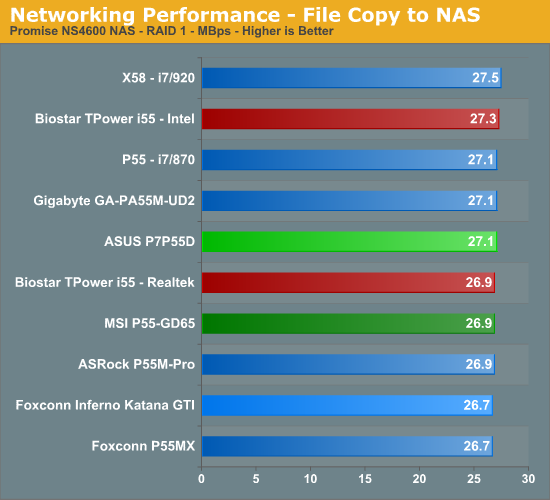
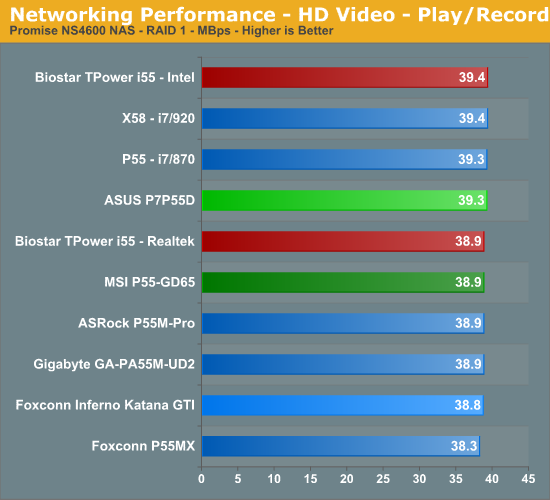
Our P55 test subjects perform almost identically in our actual usage tests with the Realtek chipsets, but the Biostar board has a slight advantage when using the Intel controller.
USB / FireWire Performance
Our USB transfer speed tests are conducted with an USB 2.0/FireWire based Lacie external hard drive unit featuring a 1TB 7200rpm Samsung drive. In the SSD to External test, we transfer a 3.82GB folder containing 2735 files of various sizes from our Kingston 80GB SSD to the Lacie drive. In the next two file tests, we use the same 3.82GB folder to transfer from our WD VRaptor 300GB hard drive to the external Lacie drive utilizing the USB 2.0 and IEEE 1394a interface.
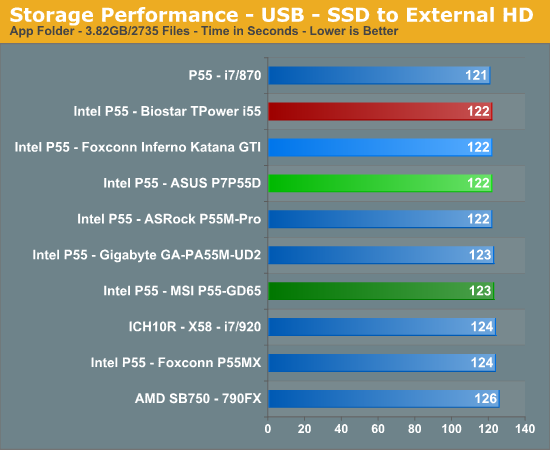
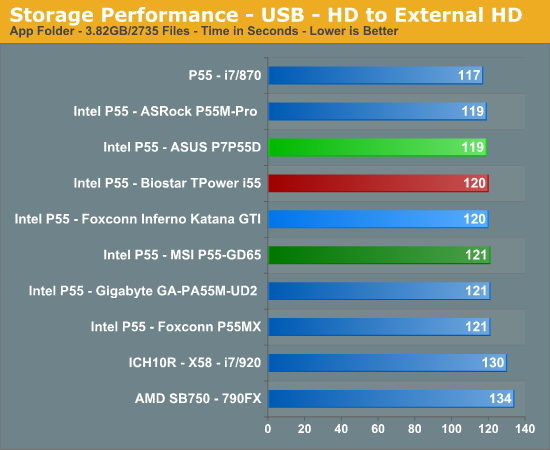
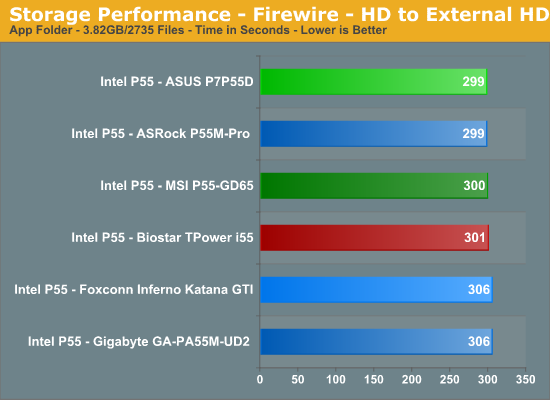
The Biostar board performs in the middle of the pack in our USB tests. The LSI Firewire controller on the Biostar board has a slightly higher write speed than the TI controllers on the Gigabyte/Foxconn boards, but is a little slower than the VIA controllers on the ASUS/MSI boards.
Storage Performance
In our storage test, we utilize the same 3.82GB test folder and transfer it from our WD VRaptor drive to our Kingston 80GB SSD.
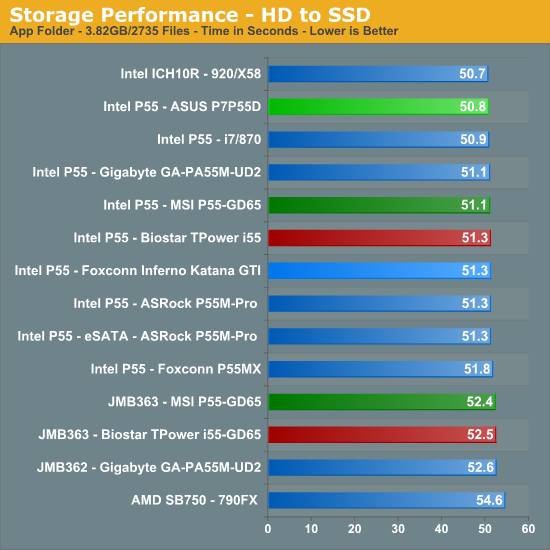
Once again, our P55 motherboards perform almost identically. The P55 chipset on the Biostar board has a 3% advantage over the JMicron controller on the same board. However, any measurable differences were not recognized in actual usage.










39 Comments
View All Comments
Joepublic2 - Thursday, November 26, 2009 - link
Rajinder, is there any way to differentiate the new foxconn sockets from the old (serial/part numbers, a visual difference between the two)?Rajinder Gill - Thursday, November 26, 2009 - link
Hi Joe,None that I know of I'm afraid. If I do find anything out, I'll update.
regards
Raja
NumericalMethods - Thursday, November 26, 2009 - link
In your great overclocking section I see you have once again exceeded the 1.21v Intel recommended Vtt specification (by a fair amount). Is this something you would be comfortable with for 24/7 running or is this just to demonstrate the limits of the board?I have no real concept of why the Vtt spec has changed from Bloomfield but if I were running a P55 system overclocked 24/7 I suspect I couldn't expect to reach a 4+GHz overclock - it would be limited by 'safe' voltage.
Rajinder Gill - Thursday, November 26, 2009 - link
The Intel voltage specifications are given out in relation to stock operating frequencies. Increase freqeuncy and you increase power, so if you're really following Intel guidelines, then you need to observe stock operating frequencies too.There is no definative answer to what kind of degredation a CPU will experience due to elevated voltage/current long term. One can assume that the degredation will be faster, but whether or not that will be a factor for the end-user is another matter. Of course, too much voltage is certainly asking for trouble. We generally run stuff just to show what the board can do. At least it answers the question for people who like to push hard. At the same time, if the board is stable at higher operating frequencies, the more sensible stuff is ceratinly possible.
regards
Raja
Absolution75 - Thursday, November 26, 2009 - link
I always find that the most relevant information to me is left out of every motherboard review.Benchmarks for motherboards are always very similar, in fact, they are so similar that in my opinion, aren't worth mentioning. If there is a strange issue with USB speeds being low (which I've seen before), then that probably is the only benchmark that really needs any type of graph. Do people really care if the board A gets a 1KBPS higher score on the network test than board B? I'm sure this is well within the margin of error of the test anyway. This may be what you're getting at when you guys have switched the conclusion to the first page of the review, which I thought was a good decision.
Relevant information that always seems to be missing:
1) Are the fan headers able to be controlled by bios? If so, how and how well? Can they all be controlled or just a few? Sometimes it specifies, but it fails to provide any real details.
2) The audio chip. Realtek did a wonderful job at creating 'optional' features on a few of their codec’s. I bought the MSI P55-GD65 board on launch date and assumed it could do real time DDL encoding (like my old gigabyte P45-UD3P which uses the same audio codec), little did I know, that this optional feature is disabled. Apparently 'true blue ray audio' doesn't really mean much. A simple paragraph about the audio chip's capabilities would be nice. Especially since some motherboards use VIA's codec’s which tend to be even more confusing than Realtek's.
3) Strange things such as mentioning who makes the chip for the NIC and other random things would be nice. For some reason, I have a good bias towards Marvell NICs. This information seems to be included more often lately :D
4) Information about how board features are integrated into the motherboard. Is that gigabyte NIC running off a PCI-E lane or PCI?
5) Useful information about strange features such TPM headers (which you made no mention of in the MSI P55-GD65).
Specifically for this review, it is said that this board is trying to compete with the MSI P55-GD65 and you say it has an advantage even though it is more expensive ($25-$45 more). How though? It is never really said. Both boards perform identically (in fact, probably any P55 board will perform identically to another. . .) and both have similar layouts. The MSI board has 1 more PCI-E slot along with an open slot PCI-E x4. How is this not an advantage? Both have dual NICs, 2 more SATA2 ports (with the MSI board having a better solution imo - the single blue slot on the board is useful for a disk drive leaving the entire 6x SATA2 ports on the P55 chipset for some type(s) or RAID) and digital audio.
Also, a complete guess, but board designers probably still include the floppy drive header just because its included in the chip they use for IDE and additional SATA (maybe jmicron doesn't make a chip that is just IDE/SATA instead of IDE/SATA/floppy), or maybe they just cost the same. . .
ereavis - Wednesday, December 9, 2009 - link
"Test Setup" is a big missing for me. What are you calling an "Intel P55" on these charts or all the Intel P55 motherboards from $90-$240 the same performance?g725s - Wednesday, December 2, 2009 - link
Cool conclusion on first page. Keep it up!Rajinder Gill - Wednesday, December 2, 2009 - link
Some seem to like it while others are not impressed (check the firs page of comments). I'll probably do some kind of exec front page summary in the future.later
Raja
treesloth - Monday, December 7, 2009 - link
FWIW, I like it. Interestingly to me, it's essentially the same layout and format that I use for my testing an analysis at work, so I actually feel sort of vindicated. :-)treesloth - Monday, December 7, 2009 - link
FWIW, I like it. Interestingly to me, it's essentially the same layout and format that I use for my testing an analysis at work, so I actually feel sort of vindicated. :-)